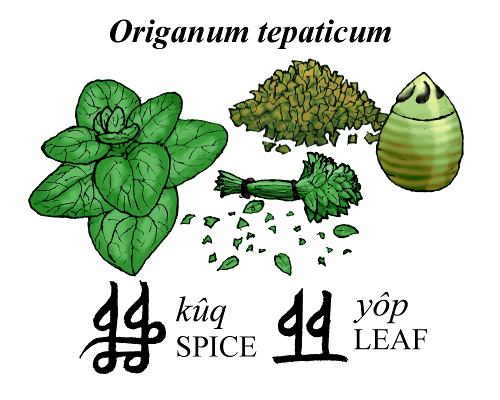Deviation Actions
Description
Western Tepat, with its “Mediterranean” climate, is the habitat of many shrubs with thick, glossy, fragrant leaves. These oil-rich herbs dry out during the summer and are prone to burn during autumn wildfires, before reviving under replenishing winter rains and fruiting in spring. Early foragers noticed them for their for their enchanting aromas, and later cultivated them for the same reason, but none more so than kûq [kɯq], Origanum tepaticum, an oregano-like spice.
The earliest records of kûq are are of people trampling it though, not eating it. Hosts would welcome visitors by scattering attractive-looking and attractive-smelling petals and leaves on the floor for them to walk on. Oftentimes a thicker bundle of spice plants would be placed next to the bed. (In fact, the glyph for kûq represents a bundle of leaves.) Walking over the plants was supposed to refresh travelers’ feet, as well as releasing the scent of the plants. The custom originated, naturally, in the western regions where kûq grows wild in abundance. The Qolup were the earliest people to deliberately grow it, and the chiefs of the Qolup tribe were greeted with kûq plants upon their earliest entrance into the historical record.
One of these chiefs is mentioned sending such plants as a gift for the accession of King Nôxhôt to the throne of Tepat. By the late Nyow Dynasty, the first thing a new king would do after being anointed with kûq oil, was to step on a bouquet set in front of the throne and proceed along a path strewn with leaves and petals. The ministers of the Conciliarity abandoned this custom to avoid making themselves seem like kings. Instead, newly appointed officials scattered a basket of leaves before spectators to demonstrate their allegiance to the people.
The custom filtered down to regular people and insinuated itself into every hopeful beginning. New buildings are opened and public projects are initiated in ceremonies where leaves are spread on the ground, much the same way that an American mayor will cut a ribbon or dig the first shovelful of dirt at a building site. Married couples step on a bouquet when they enter their new home, and their families spread leaves around the floor before they arrive.
People had also discovered that they could eat kûq, and that it tasted as good as it smells. It was first swallowed as part of palliative potions, reasoning that if it SMELLS good, it must BE good. Since then it has become a definitive element of the Tepatic culinary repertoire, reflected in its nickname mut hi yam, ‘essence of flavor.’ (Fun fact: there is another mut hi yam meaning “foothill.”) Contemporary people consume it more for flavor than for any perceived curative efficacy.
Kûq is now a generic term for spices and flavorings, but without any other specification, everyone knows you’re talking about THE kûq. Dried kûq flakes are kept on the table in a greenish-tinted shaker, along with other flavorings like salt, mint, chilis, and cane syrup. Among these, kûq is considered “neutral” between chilis (“hot,” in a red shaker) and mint (“cool,” in a blue shaker).
The crushed leaves and essential oil of kûq are used in perfumes, soaps, shampoos, and anything else that has to smell good. Although Tepat is also familiar with mint, kûq is more often used in alcoholic suspension for mouthwash. In all of these forms, kûq is also one of Tepat’s chief luxury exports.
This smelly spice has even left its scent on the modern language. To this day, guests are greeted withtaw kûq, literally ‘tread spice’ or ‘spice-foot,’ which is also shouted at many of the events where it is scattered ceremonially, imparting a wish for good beginnings. Qoq kûq ‘put down spice’ and chôl kûq‘drop spice’ are idioms that mean to make preparations for (or simply to wish and hope for) a good start - and a fragrant one, too. So if you ever hear someone shouting at you, “Spicy Foot! Spicy Foot!” take it as a compliment.




































